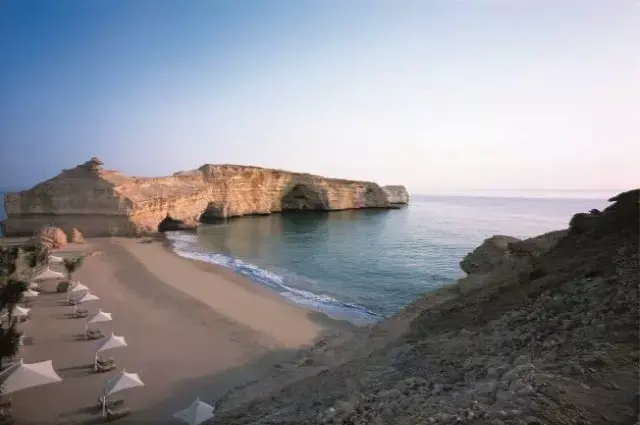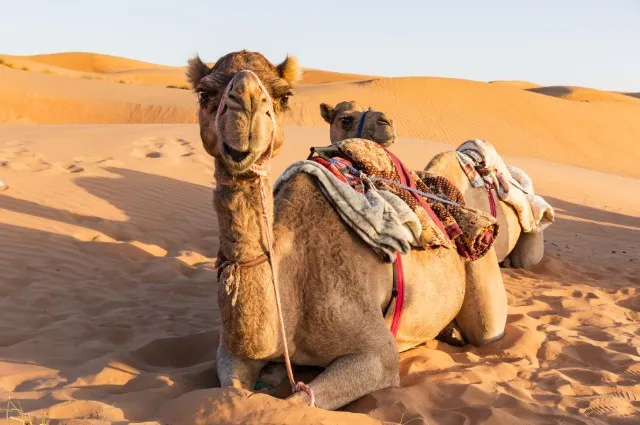Oman Specialist Holidays Travel Agent
Get in touch with our Oman specialist Clare today by email, contact form or by calling +44 (0)1580 712 690
Oman lies on the southeastern corner of the Arabian Peninsula, with a coastline stretching from the Strait of Hormuz in the north to the Yemeni border in the south. It overlooks three bodies of water: the Arabian Gulf, the Gulf of Oman, and the Arabian Sea.
Thanks to its strategic location, Oman has a rich and varied history. The Portuguese were among the first to take advantage, occupying Muscat for 143 years (1507–1650) and controlling territories such as Mombasa, Zanzibar, and other coastal areas north of Mozambique. In the 1690s, the Omanis began reclaiming control, ultimately succeeding in 1799 when the Al Said dynasty came to power—a dynasty that still rules today.
Zanzibar was particularly valuable as a center of the East African slave trade in the 19th century. Its wealth and importance prompted Imam Sai'id ibn Sultan of Muscat to build grand palaces and gardens there. However, rivalry between his two sons drew British intervention, resulting in one inheriting Zanzibar and the other Muscat and Oman.
For much of its history, the country remained divided between the coastal areas, including Muscat, and the interior—known simply as Oman—which encompasses the Al Hajar Mountains and Jebel Akhdar. Unity came with the Treaty of Seeb in 1920.
From 1932 to 1970, Oman remained isolated under a system resembling feudal rule. This changed with a bloodless coup in 1970, when Qaboos bin Said overthrew his father, Sultan Said bin Taimur. Sultan Qaboos introduced sweeping reforms, modernised the nation, and officially abolished slavery.
Today, Oman’s economy remains heavily dependent on oil exports, but tourism is rapidly growing and is expected to become one of the country’s leading industries.
Here are just a few experiences that might tempt you to step away from the beach for a day:
As of 2025, Al Mouj is ranked the second-best golf course in the MENA region.
If travelling with any medication, please ensure you carry a copy of your prescription.
Oman is an Islamic country, with most citizens following the Ibadi school of Islam. Visitors should be aware of local laws and customs: it is illegal to share a hotel room with someone of the opposite sex unless you are married or closely related, and homosexuality is prohibited.
Visitors should note that during Ramadan, many businesses and restaurants operate on reduced hours.
Musandam is just a one-hour flight from Muscat, but it’s also easily reached by car from Dubai in around 2.5 hours.
Salalah, in the far south, is about 1.5 hours by air from Muscat, with additional direct flights available from several other Gulf destinations.
Thanks to its strategic location, Oman has a rich and varied history. The Portuguese were among the first to take advantage, occupying Muscat for 143 years (1507–1650) and controlling territories such as Mombasa, Zanzibar, and other coastal areas north of Mozambique. In the 1690s, the Omanis began reclaiming control, ultimately succeeding in 1799 when the Al Said dynasty came to power—a dynasty that still rules today.
Zanzibar was particularly valuable as a center of the East African slave trade in the 19th century. Its wealth and importance prompted Imam Sai'id ibn Sultan of Muscat to build grand palaces and gardens there. However, rivalry between his two sons drew British intervention, resulting in one inheriting Zanzibar and the other Muscat and Oman.
For much of its history, the country remained divided between the coastal areas, including Muscat, and the interior—known simply as Oman—which encompasses the Al Hajar Mountains and Jebel Akhdar. Unity came with the Treaty of Seeb in 1920.
From 1932 to 1970, Oman remained isolated under a system resembling feudal rule. This changed with a bloodless coup in 1970, when Qaboos bin Said overthrew his father, Sultan Said bin Taimur. Sultan Qaboos introduced sweeping reforms, modernised the nation, and officially abolished slavery.
Today, Oman’s economy remains heavily dependent on oil exports, but tourism is rapidly growing and is expected to become one of the country’s leading industries.
Regions
Muscat
Oman’s capital is located on the east coast, known for its whitewashed, medium-rise architecture set between the Hajar Mountains and a long coastline. Key attractions include the Sultan Qaboos Grand Mosque with its vast Persian carpet and record-breaking chandelier, the Muttrah Souk, and the Bait Al Zubair Museum. Nearby excursions include dolphin watching, the historic city of Nizwa with its 17th-century fort, and the mountain reserve of Jebel Akhdar.Musandam
Musandam is a remote governorate separated from the rest of Oman, jutting into the Strait of Hormuz. Characterised by rugged Hajar Mountains, fjord-like inlets (Khors), and traditional villages. Activities include dhow cruises, snorkelling, and diving. Khasab Fort, built by the Portuguese and now a museum, is a cultural highlight.Salalah
The largest city in Dhofar and Oman’s former capital, Salalah is located in the far southwest. The region is famous for the summer Khareef monsoon (July–September), which transforms the landscape into lush greenery and offers cooler temperatures compared to the rest of the country.What to Do
Oman offers visitors a captivating blend of golden deserts, dramatic mountains, pristine beaches, and the modern comforts of a vibrant city life. Its diverse landscapes and colourful heritage create endless opportunities for exploration and discovery.Here are just a few experiences that might tempt you to step away from the beach for a day:
Explore the Dunes
From Muscat, journey to Wadi Bani Khalid, where emerald pools and hidden caves create an oasis in the desert. Continue to the Wahiba Sands and experience the thrill of ‘4x4 dune bashing’ across rolling golden sands.Sultan Qaboos Grand Mosque
No visit to Oman is complete without seeing this architectural masterpiece. Its soaring gold dome, intricate design, and vast prayer hall make it one of the most iconic landmarks in the country.Wakan Village
Begin in Barka with the bustling Fish Souq, then relax in the warm waters of Thowara Spring. Finish in Wakan Village, a spectacular mountain settlement offering terraced gardens and breathtaking panoramic views.Nizwa
Just 90 minutes from Muscat lies Nizwa, the ancient city framed by mountains and palm groves. Its imposing 17th-century fort, built to protect a vital trade route, remains one of Oman’s most visited monuments.Jabal Shams
Embark on a 4x4 adventure to Jabal Shams, the highest peak in the Hajar Mountains and home to Oman’s very own ‘Grand Canyon,’ with dramatic cliffs and sweeping vistas.Dhow Cruise in Musandam
Sail aboard a traditional Omani dhow from Khasab through the crystal waters of Musandam’s fjords. Pass remote fishing villages, and stop to snorkel or swim in secluded coves.Historical Dhofar
From Salalah, explore the old fishing village of Taqah and its historic castle, once the residence of the local governor. Continue to Sumharam, the easternmost post of the ancient incense route, then on to Mirbat, Dhofar’s former capital and the start of the Frankincense Trail. Conclude at the lush Ayan Razat spring.Qara Mountains and the Tomb of the Prophet Job
Climb the winding roads into the Qara Mountains to visit the revered tomb of the Prophet Job, set amid Salalah’s green highlands. Return to sea level for Mughsail Beach, where powerful blowholes send seawater shooting into the air at high tide.Golf
Golf in Oman is still relatively 'new', but if you are looking for a relaxing, uncomplicated few days of winter sun, you could do worse than take the short flight from the UK and see what Oman has to offer.Al Mouj
Set along a stunning 6 km stretch of Muscat’s beachfront, this Greg Norman–designed course challenges golfers of all levels, from seasoned professionals to enthusiastic amateurs. Its 18-hole championship layout is complemented by a floodlit par-3 nine-hole course, a well-stocked pro shop, a floodlit driving range, and an inviting restaurant.As of 2025, Al Mouj is ranked the second-best golf course in the MENA region.
Ghala Golf Club
What began as a modest, 9-hole sand course in 1971 is now an 18-hole championship course that plays host to the MENA Golf Tour and Oman Amateur Championships every year. Ranked among the world’s top 100 and listed in Golfscape’s “Top 30 Most Unique” courses, it sits in a mountain valley with narrow, challenging fairways. The renovated clubhouse offers an open-air porch with scenic course views.Ras al Hamra
Ras Al Hamra Golf Club is Oman’s first fully floodlit course, offering a par-71 layout played over nine holes with multiple tees and alternate greens. Designed by Graham Marsh, its desert-style design winds through arid wadis and coastal hillsides, challenging golfers of all skill levels. Facilities include a driving range, practice greens, and PGA professional coaching.Jebel Sifah Golf Course
Located about 45 minutes southeast of Muscat, the Peter Harradine-designed Jebel Sifah course is part of a luxury marina development, framed by the Sea of Oman and Al Hajar Mountains. This scenic par-36, nine-hole layout, playable as 18 holes via second pin flags, caters to all skill levels.La Vie Club
La Vie Club, formerly Muscat Hills, was Oman’s first 18-hole grass golf course. After extensive renovations, it reopened in 2023 as part of a new Muscat community development. The club features a state-of-the-art Toptracer Range, along with a golf shop, dining, and leisure facilities.Travel Advice
Entry Requirements
British and EU citizens can visit Oman for up to 14 days without a visa, provided certain requirements are met. Your passport must have at least 6 months validity from your date of entry into Oman.Medication
Please note, some prescriptions and over the counter medication are banned substances in Oman. Please contact your doctor or health professional well before travel for further advice. Oman's Ministry of Health can also be a source of advice.If travelling with any medication, please ensure you carry a copy of your prescription.
Currency
Oman’s currency is the Omani Rial (OMR), which is divided into 1,000 baisas. The exchange rate is roughly 1 OMR ≈ £1.90 as of 2025.Dress Code
Travellers to Oman are advised to dress modestly, covering shoulders and knees when outside resort areas. When visiting a mosque, full coverage is required.Language and Religion
Arabic is Oman’s official language, though English is widely spoken, particularly in tourist areas where signs are typically displayed in both languages.Oman is an Islamic country, with most citizens following the Ibadi school of Islam. Visitors should be aware of local laws and customs: it is illegal to share a hotel room with someone of the opposite sex unless you are married or closely related, and homosexuality is prohibited.
Oman Holiday FAQs
When is the best time to travel to Oman?
The best time to visit Oman is October to March, when daytime temperatures average around 25°C and conditions are ideal for outdoor activities. May to September brings extreme heat (over 40°C) and high humidity, except in Salalah, which enjoys a cooler, greener monsoon season (Khareef) from June to September.Visitors should note that during Ramadan, many businesses and restaurants operate on reduced hours.
How do you get to Oman?
Oman Air, the Sultanate’s national carrier, operates daily flights from London Heathrow to Muscat, with a journey time of approximately seven hours.Musandam is just a one-hour flight from Muscat, but it’s also easily reached by car from Dubai in around 2.5 hours.
Salalah, in the far south, is about 1.5 hours by air from Muscat, with additional direct flights available from several other Gulf destinations.


.webp)
.webp)
.webp)








